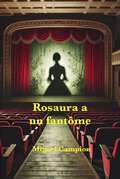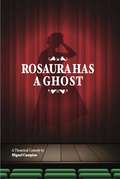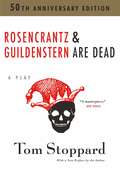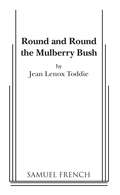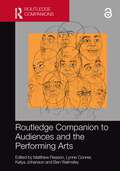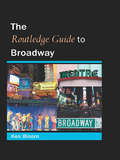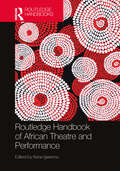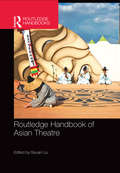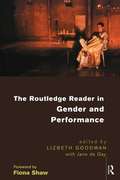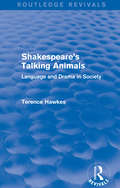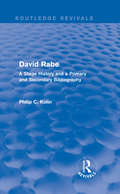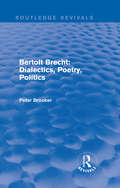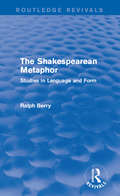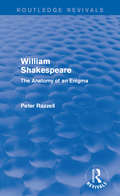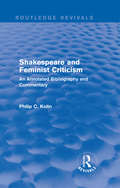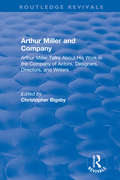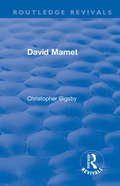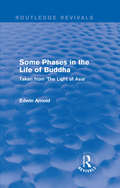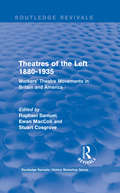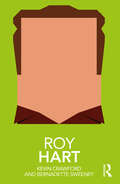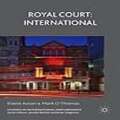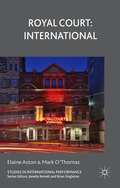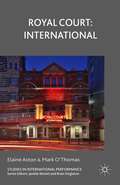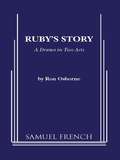- Table View
- List View
Rosaura a un fantôme
by Miguel Campion« Katarsis » est un groupe de théâtre amateur (pour le décrire de manière positive) qui survit grâce à des subventions et d’autres aides temporelles. La chef et directrice, Beatriz, a toujours des propositions artistiques risquées en tête, mais cette fois, le groupe termine par produire une œuvre classique du « Siglo de oro » espagnol, présentée au club des retraités du village. Tout va complétement changer lorsque Rosaura apparaît. Elle va leur offrir un chèque généreux pour la production de « La vie est Sainte », la pièce que sa mère avait écrit avant de mourir, qui ne vas pas reposer en paix jusqu’à ne pas voir son œuvre représentée sur scène. Même si ce texte n’est qu’une version de l’œuvre initiale avec des rythmes absurdes créés par charcutière qui n’est plus vivante (l’argent n’a pas d’odeur), ils décident d’accepter. Ils n’ont aucune idée de ce qui les attend : Rosaura exige de participer comme actrice sur scène. Ses compétences comme actrice sont pires que celles des autres acteurs, qui ne sont pas très doués non plus, mais ce qui est plus grave, c’est que Rosaura ne vient pas seule. Des problèmes, de l’ambition, de l’infidélité, des ruptures amoureuses, de la mauvaise foi, de l’absurdité, des délires et des apparitions fantasmagoriques vont se succéder lorsque l’on témoigne la dégradation et dissolution d’une compagnie de théâtre médiocre. Miguel Campion a présenté l’an 2000 sa première pièce de théâtre, « Rosaura a un fantôme », et a gagné cette année-là le premier prix du Certamen de Teatro Joven de Navarra.
Rosaura has a ghost
by Miguel Campion Dominic Zugai“Katarsis” is an amateur theatre group (to put it as kindly as possible) that just gets by on subsidies and whatever else they can get their hands on. Their leader and director, Beatrice, harbours grand plans to put on ambitious works of theatrical art, but they always end up putting on another classical piece for the retirees' theatre club in their local area. When Rosaura comes into their lives they believe everything is going to change when she offers them a juicy cheque to perform “Life is Sacred”, written by her dead mother who cannot rest in peace until the play is performed. While the text is a hackneyed pastiche of the Spanish Golden Age with absurd rhymes written by a bitter old lady who made her career in a sausage factory, the money wins out and they decide to perform the piece. Little did they suspect that Rosaura would then demand to perform a role in the play. Not only is she a poor actor with no experience, but she also brings some baggage. Quarrels, ambitions, infidelities, back stabbings, absurdities, ravings and ghostly apparitions abound as we witness the final decadence of a mediocre theatre company. This play debuted in Pamplona on the 8th of April, 2000, in the Escuela Navarra de Teatro. The production by the Xahutondo Theatre Group was extremely well received and was awarded first prize in the Navarra Youth Theatre Awards for that year.
Rosencrantz & Guildenstern Are Dead
by Tom StoppardIn Tom Stoppard’s best-known work, this Shakespearean Laurel and Hardy finally get a chance to take the lead role, but do so in a world where echoes of Waiting for Godot resound, where reality and illusion intermix, and where fate leads our two heroes to a tragic but inevitable end.
Round and Round the Mulberry Bush
by Jean Lenox ToddieComedyCharacters: 4 male, 7 femaleSimple Set Two one-act plays by internationally known playwright Jean Lenox Toddie celebrating with poignancy and humor the struggle of the heart to find its way home. Eleven colorful characters range in age from a sassy teen, to a middle-aged professor, to an old woman waiting for a bus. What bus? The bus for which we all will wait.Plays include Did You Hear the Owl Last Night? and Once Again in Glyn Kerrie.
Routledge Companion to Audiences and the Performing Arts (Audience Research)
by Matthew ReasonThe Routledge Companion to Audiences and the Performing Arts represents a truly multi-dimensional exploration of the inter-relationships between audiences and performance. This study considers audiences contextually and historically, through both qualitative and quantitative empirical research, and places them within appropriate philosophical and socio-cultural discourses. Ultimately, the collection marks the point where audiences have become central and essential not just to the act of performance itself but also to theatre, dance, opera, music and performance studies as academic disciplines. This Companion will be of great interest to academics, researchers and postgraduates, as well as to theatre, dance, opera and music practitioners and performing arts organisations and stakeholders involved in educational activities.
Routledge Guide to Broadway
by Ken BloomThe Routledge Guide to Broadway is the second title in our new student reference series. It will introduce the student to the Broadway theater, focusing on key performers, writers, directors, plays, and musicals, along with the theaters themselves, key awards, and the folklore of Broadway.Broadway is the center of American theater, where all the great plays and musicals make their mark. Students across the country in theater history, performance, and direction/production look to Broadway for their inspiration. While there are illustrated coffee table type books on Broadway, there are few that offer a comprehensive look at the key figures and productions of the last two centuries. The Routledge Guide to Broadway offers this information in an easy-to-use, inexpensive format that will appeal to students, professors, and theatrical professionals.
Routledge Handbook of African Theatre and Performance (Routledge International Handbooks)
by Kene IgweonuThe Routledge Handbook of African Theatre and Performance brings together the very latest international research on the performing arts across the continent and the diaspora into one expansive and wide-ranging collection.The book offers readers a compelling journey through the different ideas, people and practices that have shaped African theatre and performance, from pre-colonial and colonial times, right through to the 20th and early 21st centuries. Resolutely Pan-African and inter- national in its coverage, the book draws on the expertise of a wide range of Africanist scholars, and also showcases the voices of performers and theatre practitioners working on the cutting-edge of African theatre and performance practice. Contributors aim to answer some of the big questions about the content (nature, form) and context (processes, practice) of theatre, whilst also painting a pluralistic and complex picture of the diversity of cultural, political and artistic exigencies across the continent. Covering a broad range of themes including postcolonialism, transnationalism, interculturalism, Afropolitanism, development and the diaspora, the handbook concludes by projecting possible future directions for African theatre and performance as we continue to advance into the 21st century and beyond.This ground-breaking new handbook will be essential reading for students and researchers studying theatre and performance practices across Africa and the diaspora.Kene Igweonu is Professor of Creative Education at University of the Arts London, where he is also Pro Vice-Chancellor and Head of London College of Communication. An interdisciplinary researcher, Professor Igweonu has extensive experience of senior academic leadership in immersive and interactive practices and performance practice. His practice research and publication interests are in storytelling, theatre, and performance in Africa and its Diaspora, as well as the Feldenkrais Method in health, wellbeing, and performance training. A champion for arts and creative industries, Professor Igweonu is Chair of DramaHE, Council Member for Creative UK, and until August 2023, President of the African Theatre Association.
Routledge Handbook of Asian Theatre
by Siyuan LiuRoutledge Handbook of Asian Theatre is an advanced level reference guide which surveys the rich and diverse traditions of classical and contemporary performing arts in Asia, showcasing significant scholarship in recent years. An international team of over 50 contributors provide authoritative overviews on a variety of topics across Asia, including dance, music, puppetry, make-up and costume, architecture, colonialism, modernity, gender, musicals, and intercultural Shakespeare. This volume is divided into four sections covering: Representative Theatrical Traditions in Asia. Cross-Regional Aspects of Classical and Folk Theatres. Modern and Contemporary Theatres in Asian Countries. Modernity, Gender Performance, Intercultural and Musical Theatre in Asia. Offering a cutting edge overview of Asian theatre and performance, the Handbook is an invaluable resource for academics, researchers and students studying this ever-evolving field.
Routledge Reader in Gender and Performance
by Lizbeth Goodman Jane De GayThe book presents some of the most influential and widely known work on gender and performing arts, together with exciting and provocative new writings in the field.
Routledge Revivals (1973): Language and Drama in Society
by Terence HawkesFirst published in 1973, this book is about Shakespeare, language and drama. The first part introduces some common ideas of anthropology and linguistics into an area where they serve as a base for the discussion of usually literary matters. It attempts to link language to our experience of speech — examining its range, texture, and social functions. In part two, the author argues that in Elizabethan culture there was a greater investment in the complexities and demands of speech due to the widespread illiteracy of the time. It examines eight of Shakespeare’s plays, together with one of Ben Jonson’s, in light of their concern with various aspects of the role of spoken language in society.
Routledge Revivals (1988): A Stage History and a Primary and Secondary Bibliography
by Philip C. KolinIn the twenty years that preceded the publication of this book in 1988, David Rabe was in the vanguard of playwrights who shaped American theatre. As the first full-length work on Rabe, this book laid the groundwork for later critical and biographical studies. The first part consists of an essay that covers three sections: a short biography, a summary and evaluation of his formative journalism for the New Haven Register, and a detailed and cohesive stage history of his work. The second part presents the most comprehensive and authoritative primary bibliography of Rabe to date, with the third section containing a secondary bibliography — including a section on biographical studies.
Routledge Revivals (1988): Dialectics, Poetry, Politics
by Peter BrookerFirst published in 1988, this books argues with received accounts to reclaim Brecht’s emphasis on his self-described ‘dialectical theatre’, re-examining firstly the concepts of Gestus and Verfremdung and their realisation in Brecht’s poetry in terms of his attempt to consciously apply the methods of dialectical materialism to art and cultural practice. The author also takes issue with the customary view of Brecht’s career and politics which sees him as compromising either with Communist party dogma or bourgeois aesthetics, to find developing parallels between Brecht’s political and artistic though and the critical dialectics of Marx, Lenin and Mao. This development is examined in later chapters in relation to the early and late plays, The Measures Taken and Days of the Commune as well as in relation to Brecht’s changed circumstances in the years of war-time exile and in post-war East Germany.
Routledge Revivals (1990): Studies in Language and Form
by Ralph BerryFirst published in 1978, this book represents a study of the ways in which Shakespeare exploits the possibilities of metaphor. In a series of studies ranging from the early to the mature Shakespeare, the author concentrates on metaphor as a controlling structure — the extent to which a certain metaphoric idea informs and organises the drama. These studies turn constantly to the relations between symbol and metaphor, literal and figurative, and examine key plays such as Richard III, King John, Henry V, Romeo and Juliet, Troilus and Cressida, and Coriolanus. They also provide a key to The Tempest which is analysed in terms of power and possession — the dominant motif.
Routledge Revivals (1990): The Anatomy of an Enigma
by P. E. RazzellFirst published in 1990, the aim of this book is to reveal the William Shakespeare whose life has been obscured by centuries of literary mythology. It unravels a series of strands in order to understand the man and the major influences which shaped his life and writing. The first part advances the thesis that his relationship with his father directly influenced the character of Falstaff — helping to not only explain key events in his father’s life but also critical events in his own biography. This thesis not only illuminates the Falstaff plays but also a number of other works such as Hamlet. The second part focuses on Shakespeare’s own life, and includes much original research particularly on the tradition that he was a poacher of deer, discussing the influence this incident had on his later life and writings. In addition, a sociological approach has been used which illuminates a number of key areas, including questioning the view his background was narrow and provincial — which has often been used to dispute his authorship of plays of such cosmopolitan appeal.
Routledge Revivals: An Annotated Bibliography and Commentary (Routledge Revivals)
by Philip C KolinFirst published in 1991, this book is the first annotated bibliography of feminist Shakespeare criticism from 1975 to 1988 — a period that saw a remarkable amount of ground-breaking work. While the primary focus is on feminist studies of Shakespeare, it also includes wide-ranging works on language, desire, role-playing, theatre conventions, marriage, and Elizabethan and Jacobean culture — shedding light on Shakespeare’s views on and representation of women, sex and gender. Accompanying the 439 entries are extensive, informative annotations that strive to maintain the original author’s perspective, supplying a careful and thorough account of the main points of an article.
Routledge Revivals: Arthur Miller Talks About His Work in the Company of Actors, Designers, Directors, and Writers (Routledge Revivals)
by C.W.E. BigsbyFirst published in 1990, this book presents a discussion with Arthur Miller, in conversation with Christopher Bigsby. Miller talks openly and extensively about his own life and experiences, events and environments which provide material for his plays: his New York childhood, the Depression, the McCarthy witch-hunts. He discusses in depth both the technique of his writing and the moral and political questions which his plays address, and argues passionately for the importance of maintaining respect for human values in a world where they are so frequently transgressed. Interwoven with these conversations are contributions from actors, directors, designers, reviewers, and writers who have encountered Miller over the years – whether in person or through his plays – which attest to the universal and enduring importance of his work.
Routledge Revivals: David Mamet (Routledge Revivals)
by Christopher BigsbyFirst published in 1985, C.W.E Bigsby examines the career and work of playwright David Mamet. Bigsby shows that Mamet is a fierce social critic, indicting an America corrupted at its core by myths of frontier individualism and competitive capitalism. Mamet has created plays whose bleak social vision and ironic metaphysics are redeemed, if at all, by the power of imagination. No American playwright before him has displayed the same sensitivity to language, detecting lyricism in the brutal incoherencies of every day speech and investing with meaning a contemporary aphasia. Few have offered dramatic metaphors of such startling and disturbing originality. Bigsby’s study is the first book to provide a thorough account of David Mamet’s life and career, as well as close analyses of individual plays.
Routledge Revivals: Taken from 'The Light of Asia' (Routledge Revivals)
by Edwin ArnoldFirst published in 1915, this book presents a dramatization of part ofthe author's The Light of Asia. The original text represents one of the first successful attempts to popularise Buddhism and its founder Gautama Buddha — presenting his life, teachings and philosophy in verse poetry. This adaptation dramatizes part of the The Light of Asia and includes staging instructions, properties required, illustrative drawings of suggested costumes, and incidental music composed specifically for the piece. This book will be of interest to students of Indian and Buddhist literature — and how this has interacted with the West — as well as students of drama.
Routledge Revivals: Workers' Theatre Movements in Britain and America (Routledge Revivals: History Workshop Series #5)
by Raphael Samuel Stuart Cosgrove Ewan MaccollFirst published in 1985, this book examines how workers theatre movements intended their performances to be activist — perceiving art as a weapon of struggle and enlightenment — and an emancipatory act. An introductory study relates left-wing theatre groupings to the cultural narratives of contemporary British socialism. The progress of the Workers’ Theatre Movement (1928-1935) is traced from simple realism to the most brilliant phase of its Russian and German development alongside which the parallel movements in the United States are also examined. A number of crucial texts are reprints as well as stage notes and glimpses of the dramaturgical controversies which accompanied them.
Roy Hart (Routledge Performance Practitioners)
by Bernadette Sweeney Kevin CrawfordRoy Hart’s revolutionary work on the human voice through extended vocal technique and the Wolfsohn-Hart tradition has influenced several generations of practitioners. Hart’s outstanding contribution to vocal research, practice and performance stretched over 20 years until his untimely death in 1975, and his vocal training produced performers with extraordinary and highly expressive vocal ranges. He founded a theatre company, Roy Hart Theatre, that brought his ideas to realisation in ground-breaking works. His influence, through his own use of the voice for theatre and music and its embodiment in his company, was widespread, attracting the interest of directors such as Peter Brook, Jerzy Grotowski and Jean-Louis Barrault. This book combines: a detailed biography giving the social and artistic context of Hart’s work and that of the early Roy Hart Theatre an exploration of Hart’s own writings on his work, combined with a review of articles by his wife Dorothy Hart and in-depth interviews a stylistic analysis of his key works, including The Bacchae, and, L'Economiste and Biodrame, and their critical reception pathways into some of the practical exercises devised by close collaborators of Roy Hart and practitioners of the Roy Hart Theatre Tradition. As a first step towards critical understanding, and as an initial exploration before going on to further, primary research, Routledge Performance Practitioners offer unbeatable value for today’s student.
Royal Court: International
by Elaine Aston Mark O’thomasRoyal Court: International is the first full-length study of the Royal Court Theatre's International Department. It charts the engagement of the UK's premiere theatre for new writing with an internationalist agenda and takes readers inside the process developed by the Court for the workshop projects it has undertaken in different parts of the world since the late 1990s. Covering the theatre's unique programming of international plays and seasons, it highlights new writing from different parts of the globe, including France, Spain, Germany, Russia, Eastern Europe, Brazil, Cuba, Mexico, Columbia, Iran, the Near East, North Africa, Nigeria and India. First-hand accounts of the work appear in contributions from Stephen Daldry, Elyse Dodgson and Vicky Featherstone, and in interviews with Marcos Barbosa (Brazil), Anupama Chandrasekhar (India), Dominic Cooke, Sasha Dugdale, Marius von Mayenburg (Germany), Mark Ravenhill and Indhu Rubasingham.
Royal Court: International (Studies In International Performance)
by Elaine Aston Mark O’ThomasThe first ever full-length study of the Royal Court Theatre's International Department, covering the theatre's unique programming of international plays and seasons, its London-based residences for writers from overseas, and the legacies of workshops conducted in more than 30 countries.
Royal Court: International (Studies in International Performance)
by Mark O'Thomas E. AstonThe first ever full-length study of the Royal Court Theatre's International Department, covering the theatre's unique programming of international plays and seasons, its London-based residences for writers from overseas, and the legacies of workshops conducted in more than 30 countries.
Ruby's Story
by Ron OsborneDrama / Characters: 3m, 6f / June 1944. In England, Allied troops are massing for an invasion. On a small farm in Appalachia, a different kind of war is about to rage. Here, Walter and Grace share a home with four daughters: Rose, who struggles to understand why Stan - an immigrant coal miner and the love of her life - abruptly left to join the Polish Free Forces; Helga, who fears for her husband who's in the Army and - like Stan - assigned to a combat unit in England; Frieda, the family's adventure-seeking daughter, who works in a factory making uniforms and new friends, one of whom she can't bring home; and teenage Ruby who yearns to be the next Edward R. Murrow, but who must first come to grips with a family falling apart at the seams. D-Day speeds the dissolution process. But at its core is Walter's seeming allegiance to his German heritage, no matter that Helga's husband and Rose's fiancé are at war against all things German. There - through every battle - is Grace, hoping liberal doses of humor, love and understanding can restore harmony. It is adult Ruby - back for a funeral, seeking answers to questions that haunt her - who retells the family's struggle against prejudice, fear, delusion and self-loathing.
